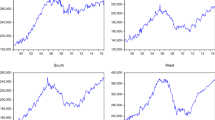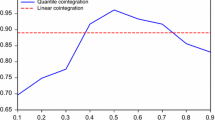Abstract
Recent real estate literature has not only proposed a few theories to explain the puzzling macro feature of the positive correlation between price and transaction volume, but also attempted to identify the causal relationships between them. However, there is little empirical evidence to explicitly illustrate how housing price dynamics measured by both past price changes and price volatility at housing unit level affect housing turnovers. Using a unique housing transaction database from Singapore condominium market, this paper reveals an interesting housing turnover pattern in response to past housing price dynamics. The results illustrate that the rise and fall of a dwelling’s price can significantly affect housing turnovers in the same direction. Higher volatility reduces housing turnovers. The effects are stronger in the domain of losses and are weakening as the cumulative housing equity rises, implying that a seller withholds the sale in the downswing of a real estate cycle in the hope that the market will rebound. The findings offer some additional micro empirical evidence to the interactions between housing price and transaction volume and imply upwardly biased repeat sales indexes.


Similar content being viewed by others
Notes
\({\text{PRICE\_EQUITY}}\left( {s{}_{0,}v,t} \right) = \frac{{PI_{t - 1} \left( {s_0 } \right) - PI_{t - v + 1} \left( {s_0 } \right)}}{{PI_{t - v + 1} \left( {s_0 } \right)}}\), where, v is the holding period (quarter). PI is the index number at location s0, t is the sale’s or censored date.
In our study, we have tried from a set of 10 dummy variables (each represents a larger range of price growth) to a set of 40 dummy variables (each represents a smaller range of price growth). The empirical results are consistent. And the results from a set of 19 variables are chosen to report.
Reference
Andrew, M., & Meen, G. (2003). Housing price appreciation, transactions and structural change in the British housing market: A macroeconomic perspective. Real Estate Economics, 31, 99–116. doi:10.1111/j.1080-8620.2003.00059.x.
Benito, A. (2006). The down-payment constraint and UK housing market: Does the theory fit the facts. Journal of Housing Economics, 12, 1–20. doi:10.1016/j.jhe.2006.02.001.
Berkovec, J. A., & Goodman Jr., J. L. (1996). Turnover as a measure of demand for existing homes. Real Estate Economics, 24, 421–440. doi:10.1111/1540-6229.00698.
Case, K. E. (1992). The real estate cycle and the economy: Consequences of the Massachusetts Boom of 1984–1987. Urban Studies, 29, 171–183. doi:10.1080/00420989220080251.
Case, K. E., Quigley, J. M., & Shiller, R. J. (2005). Comparing wealth effects: The stock market versus the housing market. Advanced Macroeconomics, 5(1), 1–31.
Chan, S. (2001). Spatial lock-in: Do falling prices constrain residential mobility. Journal of Urban Economics, 49, 567–586. doi:10.1006/juec.2000.2205.
Dubin, R. A. (2003). Robustness of spatial autocorrelation specifications: Some Monte Carlo evidence. Journal of Regional Science, 43, 221–248. doi:10.1111/1467-9787.00297.
Engelhardt, G. V. (2003). Nominal loss aversion, housing equity constraints, and household mobility: Evidence from the United States. Journal of Urban Economics, 53, 171–195. doi:10.1016/S0094-1190(02)00511-9.
Fisher, J., Gatzlaff, D., Geltner, D., & Haurin, D. (2003). Controlling for the impacts of variable liquidity in commercial real estate price indices. Real Estate Economics, 31(2), 269–303. doi:10.1111/1540-6229.00066.
Genesove, D., & Mayer, C. J. (1997). Equity and time to sale in the real estate market. American Economic Review, 87(3), 255–269.
Genesove, D., & Mayer, C. J. (2001). Loss aversion and seller behavior: Evidence from the housing market. Quarterly Journal of Economics, 116, 1233–1260. doi:10.1162/003355301753265561.
Greene, W. H. (2000). Econometric analysis, 4th edn. Upper Saddle River: Prentice-Hall.
Han, Y. H. (2005). Price dynamics and turnovers: evidence from Singapore condominium market. A thesis for the degree of master of estate management. Department of Real Estate, National University of Singapore.
Hickmand, P., Robinson, D., Casey, R., Green, S., & Powell, R. (2007). Understanding housing demand: Learning from rising markets in Yorkshire and the Humber. Research report for Joseph Rowntree Foundation, UK.
Hort, K. (2000). Prices and turnover in the market for owner-occupied homes. Regional Science and Urban Economics, 30, 99–119. doi:10.1016/S0166-0462(99)00028-9.
Iacoviello, M. (2005). House prices, borrowing constraints, and monetary policy in the business cycle. American Economic Review, 95(3), 739–764. doi:10.1257/0002828054201477.
Jin, Y., & Zeng, Z. (2004). Residential investment and house prices in a multi-sector monetary business cycle model. Journal of Housing Economics, 13, 268–286. doi:10.1016/j.jhe.2004.08.001.
Kan, K. (1999). Expected and unexpected residential mobility. Journal of Urban Economics, 45, 72–96. doi:10.1006/juec.1998.2082.
Kan, K. (2000). Dynamic modeling of housing tenure choice. Journal of Urban Economics, 48(1), 46–69. doi:10.1006/juec.1999.2152.
Kan, K. (2002). Residential mobility with job location uncertainty. Journal of Urban Economics, 52, 501–523. doi:10.1016/S0094-1190(02)00531-4.
Kan, K. (2003). Residential mobility and job changes under uncertainty. Journal of Urban Economics, 54(3), 566–586. doi:10.1016/S0094-1190(03)00086-X.
Kan, K. (2007). Residential mobility and social capital. Journal of Urban Economics, 61(3), 436–457. doi:10.1016/j.jue.2006.07.005.
Kahneman, D., & Tversky, A. (1979). Prospect Theory: An analysis of decision under risk. Econometrica, XL(VII), 263–291. doi:10.2307/1914185.
Kiel, K. A. (1994). The impact of house price appreciation on household mobility. Journal of Housing Economics, 3, 92–108. doi:10.1006/jhec.1994.1002.
Krainer, J. (2001). A theory of liquidity in residential real estate markets. Journal of Urban Economics, 49, 32–53. doi:10.1006/juec.2000.2180.
Lamont, O., & Stein, J. (1999). Leverage and house price dynamics in U.S. cities. Rand Journal of Economics, 30, 498–514. doi:10.2307/2556060.
Lee, N. J., & Ong, S. E. (2005). Upward mobility, house price volatility and housing equity. Journal of Housing Economics, 14, 127–146. doi:10.1016/j.jhe.2005.06.004.
Leung, C. K. Y., & Feng, D. (2005). What drives the property price-trading volume correlation: evidence from a commercial real estate market. Journal of Real Estate Finance Economics, 31(2), 241–255. doi:10.1007/s11146-005-1374-9.
Leung, K. Y. C., Lau, C. K. G., & Leong, C. F. Y. (2002). Testing alternative theories of the property price-trading volume correlation. Journal of Real Estate Research, 23(3), 253–263.
Nakagami, Y., & Pereira, A. M. (1991). Housing appreciation, mortgage interest rates, and homeowner mobility. Journal of Urban Economics, 30, 271–292. doi:10.1016/0094-1190(91)90050-H.
Ong, S. E., Neo, P. H., & Tu, Y. (2008). Foreclosure sales: the effects of price expectations, volatility and equity losses. Journal of Real Estate Finance Economics, 36, 265–287. doi:10.1007/s11146-007-9049-3.
Ortalo-Magné, F., & Rady, S. (2000). The rise and fall of residential transactions in England and Wales. Research report, Council of Mortgage Lenders, London, UK.
Ortalo-Magné, F., & Rady, S. (2004). Housing transactions and macroeconomic fluctuations: a case study of England and Wales. Journal of Housing Economics, 13, 287–303. doi:10.1016/j.jhe.2004.09.005.
Ortalo-Magné, F., & Rady, S. (2006). Housing market dynamics: On the contribution of income shocks and credit constraints. Review of Economic Studies, 73, 459–485. doi:10.1111/j.1467-937X.2006.383_1.x.
Parikh, A., & Sen, K. (2006). Probit with heteroscedasticity: An application to Indian poverty analysis. Applied Economics Letters, 13(11), 699–707. doi:10.1080/13504850500402096.
Rossi, P. H. (1955). Why families move: A study in the social psychology of urban residential mobility. Glencoe: The Free Press.
Schmidt, U., & Zank, H. (2005). What is loss aversion. Journal of Risk and Uncertainty, 30(2), 157–167. doi:10.1007/s11166-005-6564-6.
Sing, T. F., Tsai, I. C., & Chen, M. C. (2006). Price dynamics in public and private housing markets in Singapore. Journal of Housing Economics, 15, 305–320. doi:10.1016/j.jhe.2006.09.006.
Stein, J. G. (1995). Prices and trading volume in the housing market: A model with down-payment effects. Quarter of Journal Economics, 110, 379–406. doi:10.2307/2118444.
Sun, H., Tu, Y., & Yu, S. M. (2005). A spatio-temporal autoregressive model for multi-unit residential market analysis. Journal Real Estate Finance Economics, 31(2), 155–187. doi:10.1007/s11146-005-1370-0.
Tu, Y. (1997). The local housing submarket structure and its properties. Urban Studies, 34(2), 337–353. doi:10.1080/0042098976203.
Tu, Y. (2003). Segmentation, adjustment and disequilibrium. In T. O’Sullivan, & K. Gibb (Eds.), Housing economics and public policy. UK: Blackwell.
Tversky, A., & Kahneman, D. (1992). Advances in Prospect Theory: cumulative representation of uncertainty. Journal of Risk and Uncertainty, 5, 297–323. doi:10.1007/BF00122574.
Wheaton, W. C. (1990). Vacancy, search and prices in a housing market matching model. Journal of Political Economics, 98(61), 1270–1292. doi:10.1086/261734.
Wheaton, W. C., & Lee, N. J. (2008). Do housing sales drive housing prices or the converse? Working paper in the MIT Centre for Real Estate.
Wong, G. (2008). Has SAS infected the property market? Evidence from Hong Kong. Journal of Urban Economics, 33, 74–95. doi:10.1016/j.jue.2006.12.007.
Yatchew, A., & Griliches, Z. (1984). Specification errors in probit models. Review of Economic Statistics, 66, 134–139.
Zhou, Q. (2007). Predicting house prices for Singapore condominium resale market: a comparison of two models. Thesis in the Department of Real Estate, National University of Singapore.
Acknowledgement
We thank the support from the academic research fund (AcRF) in National University of Singapore. We thank Dr Wee Yong Yeo and an anonymous referee for their constrictive comments and suggestions.
Author information
Authors and Affiliations
Corresponding author
Appendix
Appendix
Rights and permissions
About this article
Cite this article
Tu, Y., Ong, S.E. & Han, Y.H. Turnovers and Housing Price Dynamics: Evidence from Singapore Condominium Market. J Real Estate Finance Econ 38, 254–274 (2009). https://doi.org/10.1007/s11146-008-9155-x
Published:
Issue Date:
DOI: https://doi.org/10.1007/s11146-008-9155-x




